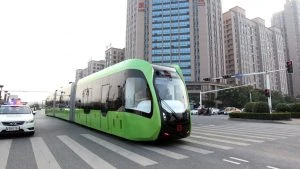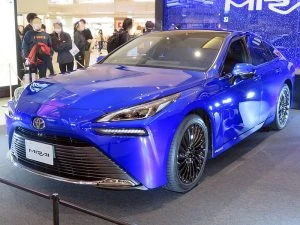Autonomous Vehicles
China’s Automotive Targets

Autonomous Bus Train
Looking at the current landscape of automotive skill, technology and manufacture, China places itself solidly at the forefront. China is a prominent global automotive game changer. The huge growth in vehicle traffic across China has been driven primarily by the country’s economic development. The growth has been immensely rapid (particularly since 2000), where the rate of motorisation of this huge country has been nothing short of phenomenal.
The Chinese government has led a massive revolution towards the urbanizing of its people. Research has shown that about 300 million people are expected to move to the cities over the next few years, where all of the existing – as well as new – cities will grow considerably with the influx of new inhabitants coming in from around the countryside. This massive development plan is scheduled to run through until 2025 and is based on clear goals and the development of good electric mobilization. Being able to integrate electric vehicles into digitised infrastructures and services will soon become a complete Chinese realization.
Currently, in China electric vehicles (EVs) are not subject to any major restrictions; if there are restrictions they are only minor. Compared with the growing costs and restrictions enforced upon combustion engine vehicles, getting yourself into an EV brings massive benefits for Chinese owners of new EVs, and the financial incentives for having an EV are strong. As early as 2013, a change of policy that favoured electric mobilization throughout China’s major cities and infrastructure was initiated. The expanding EV charging infrastructure is continuing to grow rapidly, though it has some way to go before being consistently functional over wider areas.
Big digital companies like Baidu, Alibaba and Tencent are providing the drive and expertise behind the autonomous transport network across China’s major cities. Many big brand car manufacturers from around the world have already linked with huge Chinese automotive companies seeking to use China as a platform and marriage for producing their cars at lower cost, and it would seem logical that, after entering the Western market via European brands, the first imports of premium Chinese vehicles (hybrid, EV and Fuel Cell) from China to other countries around the world can be expected over the next few years. The commercial EV sector and EV buses will likely arrive even sooner.
The Arab, Latin American and African markets are ripe for gaining access by the Chinese automotive manufacturers. Also the Silk Road Project can be perceived as a means for opening up the Asian market to the big Chinese brands of EVs and Fuel Cell vehicles.
China is on target for completely phasing out combustion technology much earlier than was first expected. At the end of 2017, Chinese car manufacturer BAIC announced plans to stop production of non-electric and hybrid cars by the end of 2025.
We see the Chinese brands like Great Wall, Haval, MG and LDV growing here in Australia, and it seems that this Chinese automotive development will continue rapidly into countries who want to take non fossil fuel transport to new levels. China will play a key, dynamically strong role in the future of clean automotive transport. I wonder how soon we’ll see more autonomous and EV transport being rolled out in Australia?
Japan’s Automotive Brilliance

Tokyo, Japan
You can’t go anywhere around Australia without noticing just how many Japanese made vehicles are motoring around our roads (and off them). Since the 1960s, Japan has been among the top 3 automotive manufacturers in the world. The country is home to a number of motor companies, and you’ll be familiar with them: Toyota, Honda, Nissan, Mitsubishi, Suzuki, Subaru, Isuzu. There are, of course, more than these mainstream manufacturers. Japan has around 78 car-manufacturing factories in 22 regions, and these employ over 5.5 million people (more than the entire population of New Zealand).
The strong competition that is happening on a global scale in the automotive industry has forced the manufacturers to come up with a new model design every four to five years. Along with the new models, new innovative designs and new technologies are presented and used by the automakers in their new vehicles. Automotive manufacturing is the prominent manufacturing type in Japan, which takes up 89% of the country’s manufacturing sector. A large amount of time and money are invested into developing and improving the automotive manufacturing process, which, in turn, increases the quality and efficiency of their manufactured automotive products.
Some of the brilliant new developments from Japan automobile manufacturers have led to distinct and innovative new designs for current and future automobiles. In order to control the market dependency on fuels, and in order to design vehicles that are more fuel-efficient, Japanese automakers have invested and built hybrid vehicles and fuel-cell vehicles.
The ideology and popularity of environmentally friendly vehicles is creating a wave of global interest and demand for these sorts of vehicles. More and more automakers around the globe are focusing on creating the types of vehicles that are friendlier on the environment to their production line. Japan’s automotive manufacturers are leaders in this field. Japanese innovations in these technology sectors include autonomous taxi services and airport transportation, high-definition maps and open-source software modules for autonomous vehicles, advanced hydrogen fuel cell and alternating-current battery technology, and silicon carbide (SiC) semiconductor films for EV power electronics. Japanese companies have been developing hydrogen fuel cell technology, which is projected to reach a market size of approximately $43 billion by 2026, growing at a CAGR of 66.9% from 2019 to 2026. Japan’s prowess in creating autonomous vehicles and their resulting cutting edge safety features puts them well ahead of the game.
An electric vehicle is an automobile that produces power from electrical energy stored in batteries instead of from the burning of fossil fuels. Top automakers such as Toyota, Honda, and Nissan are already class leaders.
Hybrid vehicles use two or more distinct power sources to move the car. Typically, electric motors combine with traditional internal combustion engines to produce power. Hybrid vehicles are highly fuel efficient. Again, Japan’s Toyota motor company is one of the automotive industry leaders in hybrid vehicle research and production – with the Toyota Prius model leading the way. Hybrid variants are available on many of Toyota’s collection of new vehicles.
A Fuel Cell Vehicle is equipped with a “Fuel Cell” in which electricity is generated through the chemical reaction between hydrogen and oxygen. This chemical reaction provides the source of power to the motor. Fuel cell systems operate by compressing hydrogen made from natural gas and gasoline, which is then converted to hydrogen by on-board systems. Toyota’s latest fuel cell vehicle, the Mirai II, is sold in Japan. The Mirai II uses a Hydrogen Electrochemical fuel cell that creates 130 kW. The electric motor that is powered by the fuel cell produces 136 kW and 300 Nm. It’s very stylish, too.

Toyota Mirai II
Tesla Reinvents Their Wheel For 2021.
Tesla has revealed updates to their Model S. The big sedan has been given tweaks to the exterior, the drive, train, and the interior. Also, gone is the Performance model and replaced by the Model S Plaid and Model S Plaid+.
Front and centre, well…left on American spec cars, is a major change to the wheel. It’s no longer round or even vaguely ovoid. It’s a yoke, not unlike those found in fighter jets. A broad “U” shape, a pair of spokes join the verticals at hub height and allow a broader view of the digital screen. It’s sure to cause controversy and pub discussion, but that’s not the only change. The large centre console screen has been tipped 90 degrees to a landscape orientation and is set into the dash rather than standing proud. Tesla say it’s more a gamin screen than anything with ten teraflops of processing power.
There’s more carbon fibre or wood trim covering parts of the dashboard and door panels, and the door cards have been redesigned and appear to feature much-needed additional storage space. The stylish new centre console also has more storage space and comes complete with wireless charging for multiple devices. The rear seats look more sculpted and feature a new fold-down armrest with cupholders.
Rear-seat passengers get an 8-inch screen that offers the same infotainment and gaming functions as the main screen, and it even works with wireless gaming controllers. The Model S has three-zone climate control, a 22-speaker audio system, heated seats all around (and ventilated front seats), ambient lighting and a glass roof as standard. White, black and beige remain the only interior color options.

The exterior has been gently massaged. There the same coke bottle flanks, slightly reprofiled slimline front and rear lights, and coupe style profile. The front bumper has been reprofiled, losing the blunt end from top to bottom, and now adds a gentle curve to split the look horizontally, including a cooling airvent, as it wraps around to each wheel arch and extends a bottom lip ever so slightly. The rear valance has also been changed and looks more like a pair of exhausts tips hiding on each side.
Underneath are now three motors. The new Plaid and Plaid+ will offer a scintillating 1.99 seconds (Plaid) to see the 100kph mark, cross the 400 metres in just over nine seconds, and 200mph/320kph in the top speed matter. Current pricing, says Tesla, is US$121,190 Model S Plaid and US$141,190 Model S Plaid+. Expected range is now 520 miles or 837 kilometres.
The Model X will come with only one three motor variant, and should see the tonne in 2.5 seconds. Top speed for the SUV is around 163mph/262kph and a range of around 340 miles or 547 kilometres. Pricing starts from US$121,190, the same price as the Model S Plaid and US$40,000 more than the Long range bi-motor Model S.
Robert Opron and the Simca Fulgur: Better Than Nostradamus?
The question as to where all the flying cars are now that we’re in 2020 has become a bit of a cliché. It’s been a bit of a cliché ever since we hit the new millennium. This is a reference to the way that popular culture envisioned what family cars would look like in the 21st century.
However, at least one car designer had ideas that were a bit more down to earth – literally. The year was 1958 and the designer was Robert Opron. This designer had accepted a challenge to produce a concept car for the 1959 Geneva Motor Show for his parent company Simca. Never heard of Simca? This was a French company owned by Fiat that rivalled Citroen for the title of “France’s answer to the VW Beetle”. I owned one back in my student days – possibly a Simca 1300; it had a front engine like a normal car rather than a rear engine and it’s probably worth a mint now, so I’m rather regretting selling it. Its only quirk was a flaw in the speedo: after it hit 50 mph, the needle went back down even when I accelerated.
Anyway, enough memories of student cars and back to Robert Opron. Opron later took his genius to Citroën, then Renault, then Alfa Romeo. He has been recognised as one of the top 25 designers of the 20th century, although he wasn’t the chap responsible for the very distinctive Citroen 2CV. The Renault Alpine was his, though, as were a number of 1980s Renaults.
Opron had come across a challenge issued by the Journal de Tintin. Yes, that’s Tintin as in the intrepid red-haired reporter who has a dog called Snowy and a best friend called Captain Haddock. The challenge was to design a “typical” car for the 1980s or for the year 2000. The challenge included a list of specifications that had to be included in the design, including the following:
- fuelled by a nuclear-powered battery or a hydrogen fuel cell with a range of 5000 km
- running on two wheels, balanced gyroscopically, at speeds over 150 km/h,
- voice controlled
- radar guidance for navigation and for detecting hazards
- top speed of over 300 km/h
- automatic braking if it detected a hazard
- headlights that adjust automatically with speed
Although Opron didn’t produce a full working prototype, he did show a shell of the concept at the 1959 motor show and the full details of the concept car, known as the Simca Fulgur, were published in the Journal de Tintin (this suggests that it would have appeared alongside The Red Sea Sharks and/or Tintin in Tibet – just in case you were curious, like I was).
The Simca Fulgur – which takes its name from the Latin word meaning “lightning” – looked like the classic Jetsons flying car, except it didn’t fly. It captured the public imagination somewhat and became the basis for what people thought futuristic cars would look like. Or what UFOs would look like – take your pick.
 Anyway, from the perspective of late October in 2020, 61 years later, it’s amusing to take a look at the cars of today and see how close we’ve actually come to getting some of these features. How well did the Fulgur predict what we’d have on our roads?
Anyway, from the perspective of late October in 2020, 61 years later, it’s amusing to take a look at the cars of today and see how close we’ve actually come to getting some of these features. How well did the Fulgur predict what we’d have on our roads?
- Voice control: Yes, we’ve got this, although it’s not quite a case of telling the car your destination and letting it get there (they’re working on that). But you can use voice control on quite a few things, including the navigation system.
- Top speed of over 300 km/h: Yes, but most cars that are capable of this have their speeds limited for safety purposes.
- Autonomous braking and hazard detection: Yes. However, human input is still needed.
- Automatically adjusting headlights: Yes, although they adjust for the ambient light levels rather than how fast you’re going.
- Electric motor with hydrogen fuel cell technology: Yes, although the range isn’t anywhere near what was predicted. We’d all love a range of 5000 km in an EV (electric vehicle) or HFCV (hydrogen fuel cell vehicle).
- Electrical motor with nuclear power: Are you kidding me? Since Chernobyl and Fukushima, nuclear power isn’t quite the sexy answer to our energy problems that it was back in the 1950s.
- Balancing on two wheels with gyroscopic stabilisers at speeds over 150 km/h: No. Just no. If you want that sort of thing, get a motorbike, not a family saloon.
All in all, not too bad a job of predicting the future, Monsieur Opron – you did a better job than your compatriot Nostradamus.